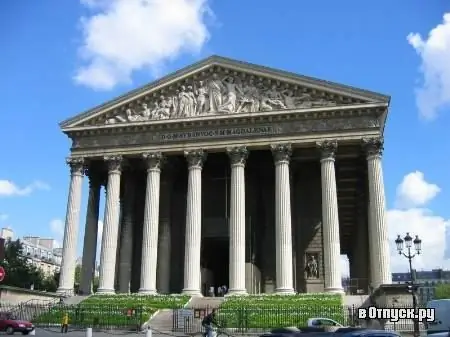
Description of the attraction
Church of st. Parisians call Mary Magdalene informally - Madeleine. It looks unusual - like a Greek temple, and has an amazing history: for 85 years of construction, the project has changed several times, depending on the regime.
Once on the site of the present church there was an old one, also St. Mary Magdalene. They were going to restore it, the first stone was solemnly laid by Louis XV in 1763. However, by the beginning of the 1789 revolution, only the foundation and the portico were ready. The revolutionaries debated for a long time whether the building would serve the people - a library or a market. But it was here that the body of Louis XVI was brought after the execution, here he was quickly buried and buried, thrown into quicklime in a small cemetery nearby. Later, the remains of the king and his wife were reburied in the Basilica of Saint-Denis.
And the church was demolished in 1799. In 1806 Napoleon decided to build a temple of the Glory of the Great Army on this site. The architect Vignon began work, they went slowly. After the fall of Napoleon, Louis XVIII demanded that the building become the church of St. Mary Magdalene. Then they almost decided that it would be better to use it as a station. Finally, in 1842, the new church was consecrated.
The long-suffering Madeleine turned out to be the standard of French classicism architecture. The building is surrounded by 52 Corinthian columns 20 meters high. On the pediment there is a sculptural image of the Last Judgment by Lemer (with the kneeling figure of Mary Magdalene, interceding before Christ for sinners). The bronze doors are decorated with reliefs on the theme of the Ten Commandments. Above the altar there is a statue depicting the ascension of Mary Magdalene (by Marochetti), and the half-dome above it is decorated with a fresco by Ziegler "History of Christianity". Sculptures, mosaics, gilding - everything shimmers in the semi-darkness: the church has no windows and is illuminated through the vault. The organ was built by Cavaye-Col himself; the organists in Madeleine were many celebrities, including Saint-Saens, Dubois, Fauré.
Madeleine stands on the square of the same name, inscribed in the ensemble of the Place de la Concorde. Hundreds of thousands of tourists visit the temple every year. At the same time, the parish lives an ordinary life. Here, as it should be, they catechize, baptize, marry, sing, and serve Holy Masses every day.
Description added:
Gennady Grigorenko 2017-27-06
Hello! If we compare the plan of the Madeleine church with the plan of the Exchange by Thomon de Tom and the early plan of the Exchange in Paris, we will see that these projects are constructively close to each other.
en.wikiarquitectura.com/wp-content/uploads/2017/01/La_Madeleine_28529.jpg
Exchange building plan with stylobate and stupas
Show all text Hello! If we compare the plan of the Madeleine church with the plan of the Exchange by Thomon de Tom and the early plan of the Exchange in Paris, we will see that these projects are constructively close to each other.
en.wikiarquitectura.com/wp-content/uploads/2017/01/La_Madeleine_28529.jpg
Exchange building plan with stylobate and steps
www.hermitagemuseum.org/wps/wcm/connect/14750c0a-75f8-4d4c-8e0e-7337516f945c/WOA_IMAGE_1-j.webp
Hide text






